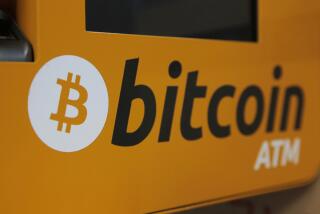Don’t Be Duped by Counterfeit Currency
- Share via
When Daniel Spaulding returned a prefabricated door to a Lowe’s home improvement store in Burbank, he never imagined he’d get pulled into the burgeoning counterfeit currency trade.
But the crisp $100 he received as a refund was rejected when his wife later tried to spend it.
“My wife’s hairdresser swiped it with a counterfeit detection pen and said it was a fake,” Spaulding said.
He took the bill to his bank, where a teller called the Secret Service and read the agent the bill’s serial number. “Send it in,” the teller was told. “It’s counterfeit.”
Spaulding learned the hard way what government investigators have known for years. Despite a recent revamp of U.S. bills aimed at thwarting counterfeiting, the manufacture of fake currency is a booming -- and highly illegal -- business.
Some $43 million in fake currency was circulated nationwide in 2002, said Philip Elston, assistant to the special agent in charge of the Secret Service’s Los Angeles office.
That’s down from the record year 2001, when more than $47 million in counterfeit currency was passed, but up 40% from 1996, when U.S. dollar bills underwent a major redesign to add more security features.
Los Angeles, New York and Miami consistently vie for the title of counterfeit capital of the country, Elston said. The L.A. office of the Secret Service seizes about $100,000 in counterfeit currency each week.
In 1996, the government added color-shifting ink, micro-printing, watermarks and other embedded images in U.S. currency to thwart crooks using new printing technology that made fakes increasingly hard to detect, said Claudia Dickens, a spokeswoman for the Bureau of Engraving and Printing in Washington.
But counterfeiting continues to be such a problem that the agency is planning to revamp the currency again this year -- and expects to continue making changes every few years in an effort to stay ahead of developments in printing technology.
As Daniel Spaulding learned, the cost of counterfeiting can be personal. When counterfeit money is seized, the consumer or company that discovered it isn’t compensated for the loss, government officials said.
“The government does not take a loss on counterfeit currency,” Elston said. “The sad thing is that whoever has it when it’s discovered takes the loss.”
Spaulding lucked out, however. A prop specialist for the movies, he’s a regular at Lowe’s. The company agreed to compensate him for the bill that was seized. A few weeks later, Spaulding’s bank contacted him with more good news.
On closer examination, the Secret Service determined that Spaulding’s bill was real. It had been seized because it was a “pattern bill” -- real U.S. currency that’s sent through a scanner by a counterfeiter to be reproduced over and over again via computer and inkjet printer.
It apparently failed the counterfeit detection pen test because it had been treated with starch, which is not found in real currency but is used by counterfeiters to make bills crisper and easier to scan.
The Secret Service thought the bill was a fake because the same serial number had cropped up on other bills. (Spaulding returned the second $100 to Lowe’s.)
False positives -- or negatives -- are one reason the Secret Service doesn’t recommend consumer products such as counterfeit detection pens to detect fake bills, Elston says.
He maintains that the only foolproof way to spot a fake is to look and feel. Real U.S. bills have numerous fine lines that don’t show up on fakes, he said. Moreover, the printing on real bills is raised. You can feel the texture by running a fingernail across the garment of the historical figure depicted on the bill, Elston said.
Hold one of the redesigned bills up to the light and turn it a bit, and the green ink on the front of the bill will appear dark. The redesigned bills also contain a second image of the portrait that can be seen only when the bill is held to the light. This, too, can’t be duplicated by computer-generated fakes.
The key is vigilance. Once the consumer has accepted money and walked away, banks and retailers are not obligated to replace it. Meanwhile, those who try to pass a bogus bill to avoid taking a loss are participating in a felony.
“You need to look your currency over when you receive it -- even if you’re at a teller window,” Elston said. “I get a few strange looks when I do it. But then if you have a question about a bill, you can simply say: ‘I don’t like this bill. Could you give me another one please?’ ”
Times staff writer Kathy M. Kristof, author of “Investing 101” (Bloomberg Press, 2000), welcomes your comments and suggestions but regrets that she cannot respond individually to letters or phone calls. Write to Personal Finance, Business Section, Los Angeles Times, 202 W. 1st St., Los Angeles, CA 90012, or e-mail kathy.kristof@latimes .com. For past Personal Finance columns, visit The Times’ Web site at www.latimes.com/perfin.
More to Read
Sign up for Essential California
The most important California stories and recommendations in your inbox every morning.
You may occasionally receive promotional content from the Los Angeles Times.












